|
Olaf Carl Wieghorst was born to Karl and Anna Wieghorst
on April 30, 1899, in the village of Viborg, Jutland, Denmark.
Olaf's father was a display artist and a photo retoucher.
Olaf's interest in horses came early as a result of his
father's association with the Danish Dragoons and he began
riding while still a baby. His interest in horses continued
to expand and as a youth, he was a bare-back rider in the
Schumann Circus and a stunt rider for the Great Northern
Film Company. Olaf's boyhood dream was to be an American
cowboy. The passion that Olaf Wieghorst developed for horses
and cowboy life would be a source of lifelong inspiration
and reflect in his art.
|
|
|
|
Olaf at age 10
(from Olaf Wieghorst Retrospective Exibition Cowboy
Hall of Fame)
|
|
|
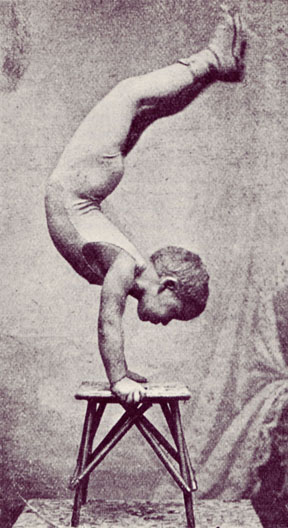 |
|
"Little Olaf
- The Minature Acrobat"
(from William Reed Book)
|
|
Olaf's father Karl believed that one of the most important
things if life was to keep physically fit. By the age of
three, Olaf's father began training him intensively in acrobatic
feats such as hand stands and the use of trapeze rings.
In 1908 when Olaf was nine his father decided it was time
for Olaf to make his professional debut as an acrobat. His
first appearance was at the Tivoli Theater in Copenhagen
where he was billed as "Little Olaf- The Miniature
Acrobat." Olaf's father encourage him to take up painting
and at the age of twelve he sold his first painting for
two Danish crowns, about forty cents American.
While working on a stock farm, he learned horseback riding
and horses became a major focus of his admiration and later
his painting.
|
|
|
When Olaf was only nineteen years he applied for special
permission to work aboard a Danish Steamer. The Danish Steamer
the "United States" set sail from Copenhagen on
December 14, 1918, for New York City. Olaf arrived in New
York on December 31, 1918 and jumped ship. He had only $1.25
in his pocket and spoke no English. He had the address of
his mother's sister Aunt Olga. Olaf spent the night, the
next day, and part of the next night riding the subways
looking for his Aunt's place. He finally found a soldier
who spoke Danish. The soldier drew him a map with an explanation
in Danish. His Uncle Alfred took him to Immigration on Ellis
Island and arranged to have his nephew "legalized."
Aunt Olga introduced Olaf to a young girl named Mabel Walters.
Olaf was immediately smitten with her. They became good
friend and Mabel undertook the task of teaching English
to Olaf.
Making his dream of going west a reality, Wieghorst served
in the 5th U.S. Cavalry on the Mexican border in the days
of Poncho Villa. He later recalled a favorite horse from
that period and said that riding through El Paso in 1921,
the horse fell on Wieghorst's ankle and broke it. The outfit
was heading to Douglas, Arizona, and not wanting to be left
behind with his injury, he stayed on the horse, which carried
him all the way through the New Mexico desert on one of
the hottest days of the year. The horse died during the
night, having expended all his energy on saving the young
soldier. Wieghorst later wrote that when the Cavalry discarded
the use of horses, "they took the soul out of that
great branch of the service." ( from Widening Horizons)
After three years of service with the Fifth Cavalry along
the Mexican border, Wieghorst was mustered out of the military
in June of 1922, and pursued the life of a cowboy, during
which he wandered extensively throughout the Southwest,
sketching whenever he could.
|
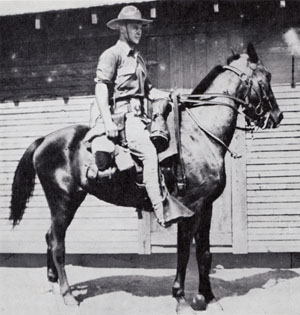 |
|
Trooper Wieghorst
on Mexican Border, 1919
(from William Reed Book)
|
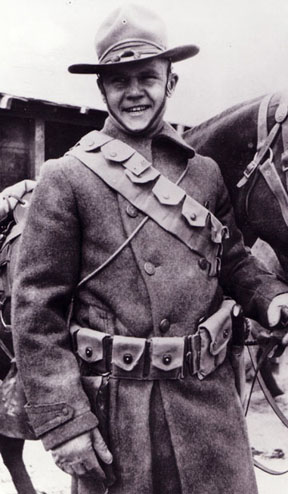 |
|
Olaf in full cavalry
uniform, 1919-1920
(from Olaf Wieghorst Retrospective Exibition Cowboy
Hall of Fame)
|
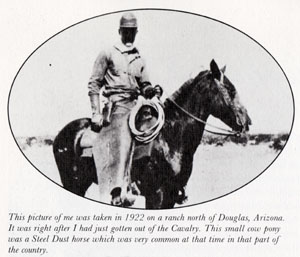 |
|
Olaf at age 23,
working on a ranch in Douglas Arizona
(from Olaf Wieghorst Retrospective Exibition Cowboy
Hall of Fame)
|
|
|
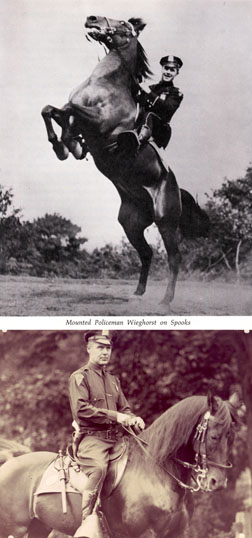 |
In the fall of 1924, Olaf returned to New York and married
Mabel Walters, whom he had met when he first arrived in
the United States. He joined the Police Department and was
sworn in on December 2, 1924. Because of his experience
with horses be was assigned to the Remount Station, where
he broke and trained young horses for the Mounted Division.
For several years Patrolman Wieghorst was part of the Police
Show Team and was the recipient of many blue ribbons and
trophies, including some at the National Horse Show held
in Madison Square Gardens. He patrolled the Central Park
bridle paths on a horse named Rhombo. During his patrols
he would stop runaway horses and help fallen riders.
Although the police department did not condone outside business
activities for its patrolman, Olaf began selling his work
through various outlets during the 1930s. He used a front
man named Charlie Aldrich, an old cowboy who had worked
for Will Rogers, and began selling drawing and etchings
in the lobby of Madison Square Garden. He shared a display
table with another painter, Pete Martinez.
|
|
|
From 1938 to 1942 Olaf's drawing and etchings were displayed
at the Madison Square Garden Rodeo and in the Rodeo's Official
Magazine.
"Olaf Wieghorst is among the best of our present Western
artists who pictures the old and the new in it's ranch and
Indian life, on the plains and mountains. As a youth he
served on the Mexican border patrol with the 5th U. S. Cavalry,
later working as cowboy and wild horse breaker on the Quarter
Circle 2-C Ranch at Alma, New Mexico. In the Garden Lobby
facing the Eighth Avenue entrance, much of his current work
is hung, offered for public sale." (from 1938 Madison
Square Garden Rodeo Magazine)
|
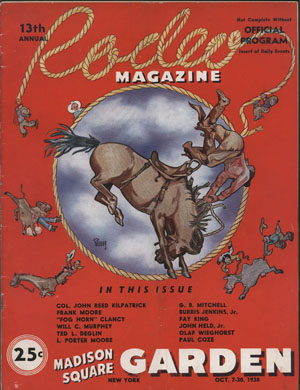 |
|
(Click on cover for a detailed view
and more images from the magazine.)
|
|
|
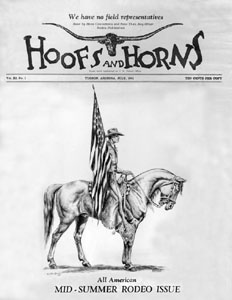 |
|
(Click on cover for a detailed
view. There is a link to more Hoofs and Horns covers
on the main web page.)
|
|
From 1938 to 1953, Olaf's art was featured on the covers
of a Rodeo magazine published in Tucson Arizona titled "Hoofs
and Horns." During the World War II years the drawings
emphasized patriotism, supporting our soldiers, and the
war effort. Shown here is a very detailed drawing of a cowboy
carrying the American Flag, from the July, 1941 issue. The
following was written about Olaf by Ethel A. (Ma) Hopkins.
Editor of Hoofs and Horns Magazine:
"The artist who made the cover for this issue hails
from New York City. Olaf Wieghorst made the dry point etching
of which this picture is a reproduction. Back in the '20s
Mr. Wieghorst was a member of the Border Patrol along the
International Border between the United States and Mexico.
Later he cowboyed in New Mexico and finally went East and
is now a mounted policeman in Central Park."
|
|
|
During the 1940's and 1950's Olaf sold many of his paintings
through the American Artist Company of New York to various
calendar producers and other commercial publishers.
Many of these earlier works were characterized by vivid
colors and a lot of action. Some publishers would commission
a painting portraying a story for a particular western theme.
Many calendars featured a single painting attributed to
a well-recognized artist of the period with tear-off pages
for each month. Most of the calendars featuring Olaf’s
art were produced by the Thos D. Murphy Company and the
Shaw-Barton company. Other calendar makers featuring his
art included Louis F. Dow Company and the A. Scheer Company.
Much of the calendar art was also published as jigsaw
puzzles. Jigsaw puzzles were a popular form of entertainment
before the advent of the television, movies and other modern
forms of distraction. Many companies were formed to take
advantage of the demand for these puzzles. They called
upon the artists and illustrators of the day to provide
subject matter for the puzzles. Popular puzzle makers featuring
Olaf’s paintings were Tuco, Perfect Picture, Guild,
Fine Arts, Blue Ribbon, Masterpiece, Whitman Publishing
Company, and Walzer.
Many of Olaf’s early works were published in “
The Toronto Star Weekly”, later named “The
Star Weekly”. “The Star Weekly” began publication
in April 1910 in Toronto, Canada. The publisher,
J.E. Atkinson, attempted to create a Canadian counterpart
to the popular British type of Sunday Newspapers. “The
Star Weekly” featured comic strips, good illustrations,
cartoons, and art. Artists found in “The Star Weekly’s”
pages included Arthur Lismer, Fred Varley, C.W. Jefferys,
and Olaf Wieghorst. “The Star Weekly” ceased publication
in 1973 due to competition from the more popular media of
television. Mae kept a scrapbook of Olaf's works featured
in calendars, puzzles, and magazines.
|
|
|
|
Olaf retired from the New York City Police Department in
December, 1944, and once again headed west, with Mae and
his son Roy. They settled in El Cajon California. Olaf lived
in a ranch style house on Renette Avenue. The house was
moved in October, 1999 and restored by the Olaf Wieghorst
Museum Foundation and is located in downtown El Cajon on
Rea Avenue.
After retiring and moving to El Cajon Olaf settled down
to paint, steadily gaining recognition for his classic cowboy
and Indian subjects and became a master painter of the western
scene. Arizona Highways devoted its March, 1971, issue to
"The Southwest of Olaf Wieghorst", and repeated
the honor again in 1974. A retrospective of Wieghorst's
work was presented at the National Cowboy and Western Heritage
Museum in 1974-75.
|
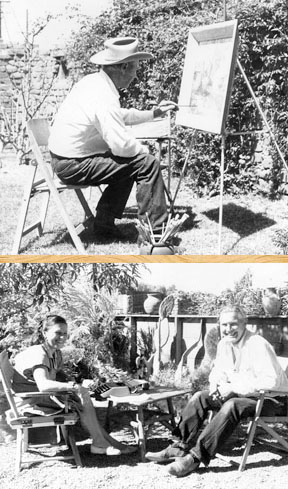 |
|
Olaf and Mae at
their Renette Ave. home in the 50's
(from Olaf Wieghorst Museum Roundup Magazine)
|
|
|
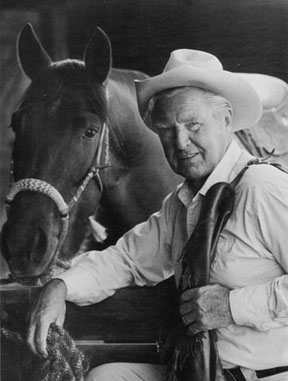 |
|
Olaf and Spooks
III
(photo by Roy Wieghorst)
|
|
Olaf was honored at the National Cowboy Hall of Fame in
Oklahoma City on November 15, 1974 for his contribution
to Western Art. A display was presented at the Hall of Fame
with more than fifty of his oil paintings.
Unlike other contemporary western artists, Mr. Wieghorst
actually lived the scenes he renders with such insight.
Cowboy, horse cavalryman, ranch hand and friend of the Indians,
he roamed the West during its transition from open range
to the modern world. He knows, first hand, the sights and
people that are brought to life with such a graceful blend
of impressionistic skill and authenticity.
Recognized as the "Dean of Western Painters",
Wieghorst's work is often compared with that of Remington
and Russell, and his paintings hang in the great public
and private collections of western art.
|
|
|